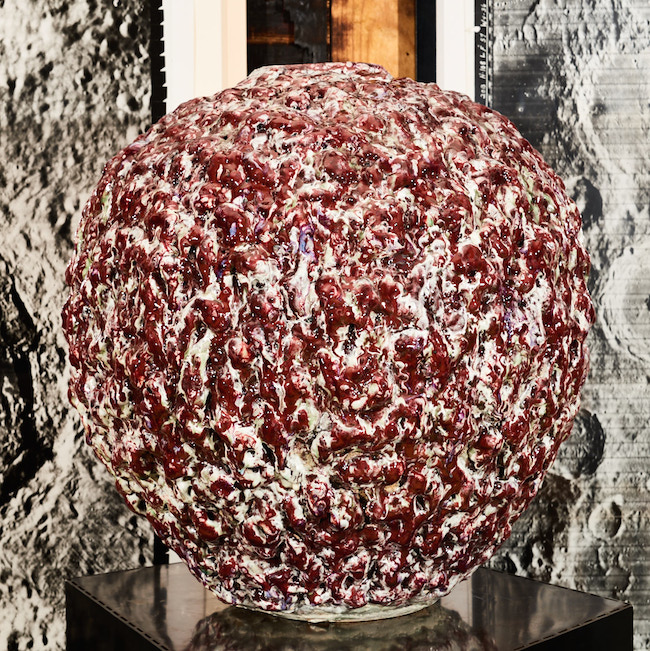NEW YORK — We’ve covered the work of Copenhagen artist Morten Løbner Espersen once or twice on CFile and today we have a new work by him that draws on the wonder of our closest celestial neighbor, the Moon. The Orb (New York, June 9 – July 30) includes “moon vessels” by the artist accompanied with photographs from NASA’s Lunar Orbiter Missions between 1966 to 1967. It is showing at the Jason Jacques Gallery.
Alongside the NASA photographs, Morten Løbner Espersen’s stoneware vessels, themselves named after the Moon, are a perfect complement to the black and white images. Spherical in silhouette and highly textured, Espersen’s Moon Vessels echo the appearance of the Moon in both shape and surface, craters and crevices lending the pieces a purposely irregular quality. Coated in shades of alternating vibrant and muted glaze, the Moon Vessels add a dimension of color to the black and white photographs, in an inspired interpretation of the same subject matter. Espersen’s Moon Vessels explore opposing principles, unifying simple oval forms with complex surfaces, which recall the volcanic surface of the pieces of Viennese sculptor Lucie Rie. Magnified by a uniquely satiny glaze that contrasts with the convoluted shapes of the sculptures, Espersen’s pieces constitute an exciting aesthetic challenge to the two-dimensional NASA photographs.
Depicting the Moon from various angles and distances, the Lunar Orbiter photographs were captured over the course of five unmanned missions from 1966 through 1967, in a program designed to photograph and assess all potential landing sites for the Apollo mission. The photographs also aimed to provide baseline imagery for future geologic analysis of the lunar surface. The first mission remains famous for producing the first photograph of the Earth from the Moon, taken in August 1966.
Derived from negatives captured with an incredibly advanced imaging system, these vintage gelatin silver prints mapped 99 percent of the Moon’s surface in high-resolution. The first three missions successfully photographed potential landing sites, while the fourth and fifth covered the entire lunar nearside and farside of the satellite. The lunar orbiters used a complex imaging system that includes dual-lens camera, a film- processing unit, a readout scanner, and a film apparatus. The resulting rolls of 70mm film were then processed, scanned, and transmitted back to Earth.
Though an inherently scientific mission, the results of this Lunar Orbiter program are beautiful, haunting images of the glowing orb that hangs in our night sky. The varying shades of black and white and spectacular views of the lunar surface create eerie silent images of tremendous beauty, which magnificently picture the moon’s relief and its many craters. The photographs, upon their release, captivated audiences who, for the first time, saw detailed photographs of the surface of another body in space. They testify to the tremendous scientific and public interest in the moon and space in the 1960s, which culminated in the first manned moon landing of 1969.
Set in Jason Jacques Gallery’s main exhibition room, the Orb Show is an adventurous pairing combining two starkly different portrayals of the Moon in a type of cosmic surrealism.
Text (edited) and images courtesy of the gallery.
Do you love or loathe these works of contemporary ceramics? Let us know in the comments.





Add your valued opinion to this post.